Laver Seaweed – Edibility, Identification, Distribution
Porphyra spp. aka. Nori, Slake
Related pages:
- Identification – 5/5 – Easily recognised: deep brown/green/purple sheets, looking like stranded black bin bags when the tide is out
- Edibility – 4/5 – A great ingredient and important member any wild food larder
- Habitat – Clinging to exposed rocks on open beaches, from about three quarters of the way down the tidal range. Also on groins, piers and harbour walls.
- Distribution – 3/5 – UK-wide but occasional and a little picky about where it will grow
- Season – November – May
- How to harvest – Mindfully harvested by cutting (never pulling) up to 2/3rds of the growing sheets, leaving plenty connected to the rock, and never clearing a whole rock or area. Don’t be put off if it clings to the rocks in dry mats – it soon rehydrates. Gathered on a receding tide it will be easier to clean.
- How to eat – Dried, toasted and crumbled as a seasoning for rice, salads, stir-fries etc and in stock powders; Or cooked, as an enricher of soups, stews etc; As a rich textural addition to pies, tarts etc; Mixed with oatmeal and fried as patties to make laverbread; the drained cooking liquor makes a thick, umami-rich stock.
Laver has no great flavour if you eat it raw, but imparts a rich, savoury, umami quality to anything it is added to. I have not found a single savoury dish that can’t be improved by its addition and it is a cornerstone of my wild larder.
Its goes chewy and awkward to use when you simply dry it, but a little toasting in the oven or in a dry frying pan brings out the nori flavour you will be familiar with in Japanese cuisine.
To use it cooked, rinse it thoroughly then simmer (adding a little water where necessary) for about 6 hours, ensuring it doesn’t boil dry. Drain and squeeze out, reserving the liquid which is the richest, most umami and nutrient rich stock you could imagine. Reduce it down to a concentrate and freeze in ice cube trays for throwing into sauces or making a glaze for meat. Keep the cooked laver in small tubs in the freezer (it doesn’t keep very well unfrozen) and add to savoury stews, soups, patés and pies.
To make laverbread, the Welsh favourite, blitz then mix the cooked, strained, wet laver with pinhead oatmeal until it becomes thick enough to roughly mould into patties (unusually for seaweed, you may wish to add some seasoning – I add pepper dulse and sun-dried white sea lettuce). Fry them in bacon fat or butter and serve. I like them with smoked fish and sea beet for brekky. Lovely and very filling.
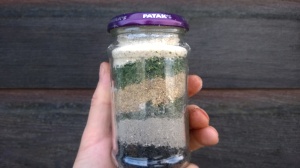
Insta-dashi stock before shaking. Made with dried, powdered ceps, cauliflower fungus, orange birch bolete, gutweed, pepper dulse and laver
Those of a geeky disposition will be interested to know that several species of porphyra are indigenous to UK waters, all of them edible and of more or less similar culinary merits. Even marine biologists struggle to distinguish between them, with habitat and gestalt being the best clues. You are most likely to encounter Tough Laver (p. umbilicatis) or winter laver (p. linearis) which is quite translucent. Another variety, Pale Patch Laver (p. leucosticta) can be found clinging epiphitically to pip weed and serrated wrack.
Another species of laver – p. yezwensis – is most usually encountered in the UK wrapped around sushi and labelled by its Japanese moniker, nori. This variety does not grow around the UK, but is farmed and harvested commercially in vast quantities around Japan. I have made several, admittedly half-hearted, attempts to make nori sheets from our indigenous porphyra species to serve around my wild sushi. The most successful efforts came out more like fish-net tights than anything that might hold rice. I’ve given up, but I have seen some respectable efforts from my friend Monica Wilde (who has rather more of an eye for detail than me). Hers came out like dark, brittle cardboard, great for breaking up and serving tit-bits on, but never likely to embrace anything. The undisputed master of sushi paper making (and all sorts of wild paper making) in the UK is Fergus Drennan – he runs courses in it down in Cornwall.
Related pages:
- Introduction to seaweed foraging
- Mile High Wild Pie Recipe (using laver)
- Wild Sushi
- How to make wild sushi rolls
- Seaweed foraging guide
- Fungi guide
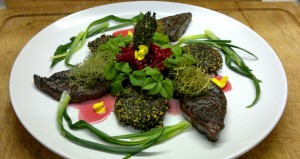
Seared roe deer liver with laverbread, chrain, ground elder, wild leeks, reindeer moss, elderberry, gorse

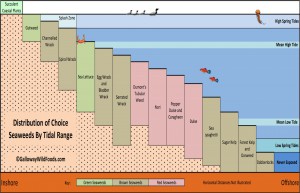
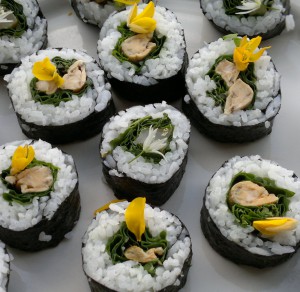

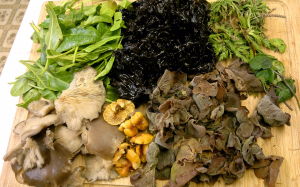
10 Comments
Thanks for the very informative article. I’d be interested to know a bit more about the drying process – how thinly you spread it, whether you use sun or wind etc – my motivation is that we have just finished simmering about 8 kilos and its going to eat up a lot of our freezer space.
Hi Mike, I use a dehydrator. I spread the seaweed on silicon mats so it doesn’t stick. The thinner you spread it, the quicker it dries. Cooked laver goes off very quickly unless it is frozen or rapidly (and thoroughly) dehydrated. Best wishes,
Mark.
Can you just dry it and use it as a garnish, as opposed to boiling?
Yes, though you’d probably want to grind it to powder after drying. Can be quite tough.
I just wash and then dry it fresh without cooking in my dehydrator, then it’s in my high power blender, ( it’s very tough) as small flakes i use a three fingered pinch in most of my casseroles and sauces. I have just renewed my years supply which is about 500 grams dry weight, which took me about 10 minutes to pick, and 1 hour to dry and prepare.
It’s funny to me that you say it has no flavour. I find it very flavoursome, a taste all of it’s own. It might be the difference in cooking. Cooking sloke, as we call it here in Ireland, as you say involves a lot of washing to remove all the sand. You might like to try my method(actually my grandfathers’) A good knob of butter in a heavy pan, add the laver a handful at a time, squeezing out as much water as you can before adding to the pot, fry in the butter until it reduces in volume, then add some more until your bucket full is added to the pot. Continue sweating the laver down until it is about half a pot full, pounding with a wooden spoon all the time, if it was long, cut with scissors. Then add boiling water until it doubles in size, cover and simmer for 4 hours. Eaten cold with hot spuds. https://www.youtube.com/watch?v=_kZQDsXLOEI
Does groin mean something different to you than it does to me? Because we don’t usually have seaweed on our groins over here in the U.S. : )
I think you do have seaweed on *some* of your groynes/groins… https://en.wikipedia.org/wiki/Groyne
Hi Mark
I’m really enjoying your seaweed content, out of everywhere I’ve searched on the internet yours is the most comprehensive. I’m based in North Cornwall and I’ve recently got into harvesting small amounts of seaweed very local to my house during the lockdown. I’m struggling to notice the difference between Laver and Sea Lettuce, do they grow on the same rock, often with the laver on top? This is how it seems to me, the bright green thinner pieces underneath or around look like thin sea lettuce and the brown thicker pieces (but never as thick as what I search on the internet) grow on top.
Any help appreciated, regards.
Hi Max,
Sea lettuce can certainly lurk under other seaweeds. It should be vibrant green v laver, with its dark purplish – black – deep olive green colour, according to the species you have, and the condition it is in. Laver is usually very thin. The two species are closely related, and can be used in similar ways, so not a big worry if you mix them up. 🙂
Mark